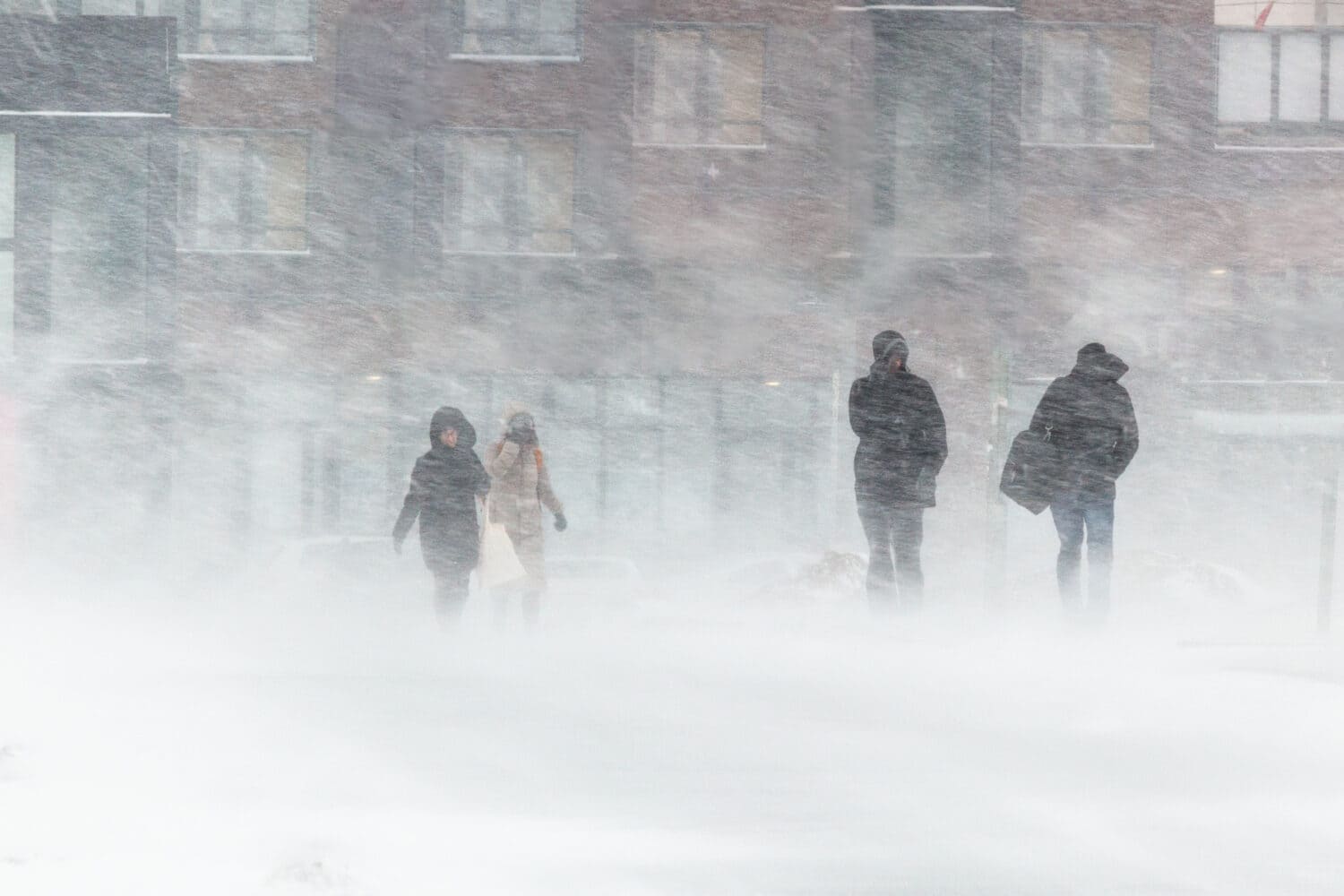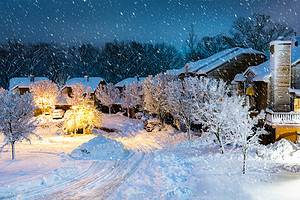Thanksgiving travelers face battling the worst traffic and busiest airports of the year as an estimated 54 million people take to the roads and the air to spend the holiday away from home. While traffic and lines are bad enough, sometimes Mother Nature steps in to remind us that she is in charge. The biggest Thanksgiving snowstorm in Colorado history was one of those times.
The Great Thanksgiving Weekend Blizzard of 1983 swept through the state with such ferocity that travel became impossible. Not only were people stuck at home, but the storm’s intensity stranded people in their cars on the roads and left thousands to ride out the blizzard in Denver’s airport.
The Great Thanksgiving Weekend Blizzard
Rated one of the most dramatic Thanksgiving Day storms in the nation’s history by the Farmer’s Almanac, the Great Thanksgiving Weekend Blizzard will make you grateful you’re only reading about the ferocity of its impact.
Travelers Stopped in Their Tracks
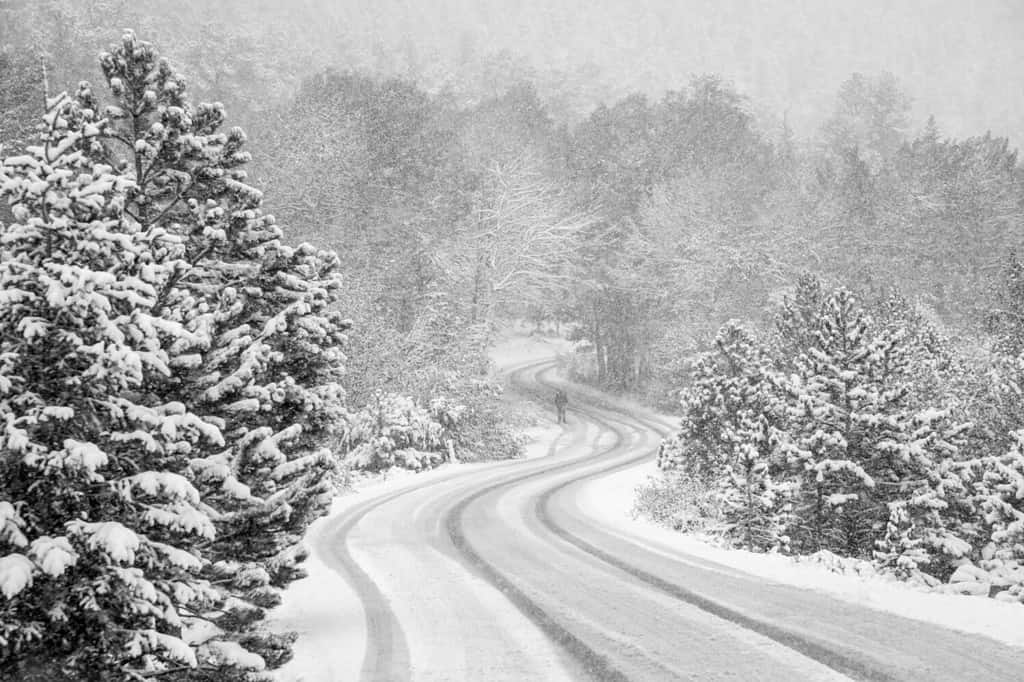
The 1983 Thanksgiving blizzard closed nearly all interstates around Denver.
©Bob Pool/Shutterstock.com
Just as people were wrapping up the 1983 Thanksgiving holiday weekend, a now infamous November blizzard trapped thousands of travelers and brought seven middle Western states to a standstill under the weight of record-breaking snowfall and wind gusts.
On the Saturday and Sunday after the holiday, Nov. 26-27, 1983, the slow-moving storm moved in from the Pacific Ocean and closed major highways and airports from Oklahoma and Colorado to upper Michigan. Hundreds of motorists were forced to take shelter in National Guard Armories, churches, firehouses, and truck stops as visibility made driving impossible.
In Colorado’s capital of Denver, 21.5 inches of snow buried the ground in just 37 hours. In Colorado’s high-plains town of Limon, residents needed to dig their cars out from under two feet of snow, with some unlucky people finding their vehicles entombed beneath 15-foot drifts.
The Colorado Springs Gazette-Telegraph reported that “residents of Limon were holiday weekend hosts for 3,000 travelers stranded when Interstate 70 was closed because of blowing snow that piled into drifts as high as 15 feet.” Along with Interstate 70, interstate highways were closed in all directions except for west from Denver.
Stranded at the Airport
Another 3,000 wayward travelers spent the night of the storm at Stapleton International Airport in Denver where 22 inches of snow fell forcing officials to close the airport for 24 hours. Winds at the airport gusted to 36 mph on Nov. 26 and to 29 mph on Nov. 27. However, most wind speeds seen across metro Denver were 15-30 mph.
Snow and Cold
Snow depth across metro Denver varied from 15 inches in Commerce City to 28 inches near Chatfield Reservoir. At least an inch of snow remained on the ground for 63 consecutive days after the storm until Jan. 27, 1984, making this the longest period of continuous snow cover ever recorded in Denver history.
A bone-chilling cold front gripped Denver in temperatures that hovered in the teens and lower 20s. The combination of snow, cold, and wind contributed to the cancellation of high school football games over the weekend and stores remaining closed on some of the busiest shopping days of the year.
This monster storm was sandwiched between two smaller storms that hit Colorado a week before and a few days after the Thanksgiving blizzard. Neither packed the powerful punch of the holiday heavyweight, though.
Discover the 11 worst blizzards in the United States.
Deaths During the Storm
Tragically, the biggest Thanksgiving snowstorm in Colorado history claimed the lives of 61 people.
Colorado, Nebraska, Iowa, South Dakota, and Minnesota were hit the hardest. But the wide range of the blizzard led to storm-related deaths occurring as far away as Arizona, Kansas, Utah, Wyoming, Montana, New York, North Dakota, Texas, Pennsylvania, and Wisconsin.
Six people died in Colorado because of the blizzard. Two Commerce City, CO, teenagers died after their car rolled over into an open area during the snowstorm. They spent several hours exposed to freezing temperatures lying in the open before they were spotted by a passing motorist. By the time they were treated at the hospital, it was too late. Another two people in Colorado were killed after their plane crashed in the bad weather.
Storm-related plane crashes took the lives of people in five different states. Six people were killed in Georgia during a thunderstorm when their plane crashed into a rural North Georgia mountain. Four people in Texas, four in Arizona, and two in Pennsylvania fell victim to the storm’s severity while flying.
Road accidents also took a heavy toll with authorities attributing 37 deaths in total to traffic-related injuries during the storm.
Stories from the Storm

First responders used snowplows during the Thanksgiving storm.
©iStock.com/kevinmwalsh
The Thanksgiving Day blizzard affected millions of people all over the country only 40 years ago. It’s likely every person who lived through the storm has a story to tell. But there were a few notable stories from Colorado that made it into area newspapers.
With so much destruction attributed to the storm, good news was a welcome change when the New York Times reported on the birth of a baby during the height of the blizzard. Although snowplows were useless in the blowing snow, a physician rode one to a home to deliver a baby boy in Limon, CO, a town that sits on the then-closed Interstate 70.
Snowplows appeared in another blizzard story when firefighters commandeered the vehicles to reach a house fire off Interstate 70. But by the time a few of their smaller firetrucks were able to reach the house it had been totally engulfed in flames. Those volunteer firefighters also searched for a lost hunter, delivered baby formula to a family stranded on their farm, brought insulin to diabetics, rescued two pregnant women, and housed and fed 15 people stranded in the area at the Bennett, CO, firehouse.
Financial Costs of the Blizzard

Denver officials depend on the region’s sunny skies to help clear snow from the ground after a storm.
©Virrage Images/Shutterstock.com
Big snowstorms are relatively rare in the Mile High City where warm, sunny days are common throughout the winter. Denver’s urban core receives an average of 60 inches of snow annually, with most storms leaving no more than 3 inches of snow on the ground.
Because the city is rarely throttled by a mega storm like the Great Thanksgiving Weekend Blizzard, it doesn’t have the resources on hand to combat the effects of such storms as do snow-belt cities with colder climates.
This makes it financially more costly to recover from damages and remove all the snow from city streets. Historically, Denver has spent an average of $5.5 million on snow removal each year. Neighboring Boulder, CO, by contrast, averages about one-quarter of that amount, at $1.37 million, and spends between $350,000-$400,000 per storm.
After the biggest Thanksgiving snowstorm in Colorado history, Denver spent a whopping $1.5 million on snow removal alone. Other damages, including the economic impact of lost business at a time before internet shopping, surely cost the city much more.
Mistakes Made During the Storm

The snow during the Thanksgiving blizzard covered cars and homes in up to 28 inches of powder.
©Anne Kitzman/Shutterstock.com
Denver officials did their best to protect people from the effects of the storm. But after the snow stopped falling, they admitted to making a few errors in judgment.
While cars parked on major city streets were supposed to be moved so that snowplows could work on removing snow, officials didn’t declare an emergency until 17 inches of snow blanketed the ground. By that time, cars that needed to move were already buried.
The National Weather Service (NWS) in Denver admitted “bad judgment” when it prematurely lifted its winter storm warning. At 3 p.m. on Saturday, Nov. 26, after about 10.5 inches of snow covered the ground in Denver, the weather service replaced the warning with a travel advisory. By 9 that evening, forecasters realized that they had been led astray by a lull in the storm.
Because of the rarity of such massive storms and Denver’s sunny climate, the city has long employed the warmth of the sun in its snow removal strategy. Since the 1920s, Denver officials have taken the approach that allowing the sun to melt much of the snow saves taxpayer money, is easier on the environment, and causes less trouble for people needing the park on the street.
But this tactic didn’t work after the Thanksgiving storm of 1983. Skies never cleared enough to let the sun do its work before the next storm dropped more snow on the city. Temperatures didn’t cooperate either. That December still holds the record for the coldest December in Denver’s history with a mean temperature of 17.4 degrees Fahrenheit. These factors contributed to the record 63 days of continuous snow cover in Denver after the storm.
How Do Animals Fare in Extreme Cold?
Colorado is well known for its diverse geography. The Rocky Mountains, the largest mountain system in North America, runs right through the middle of the state, dividing it between the eastern plains and the western slope. Along with rugged mountains, Colorado boasts vast plains, arid deserts, river canyons, and mesas. With its treasure of natural terrain, it’s no surprise the state is home to a wide variety of animals.
Big Game
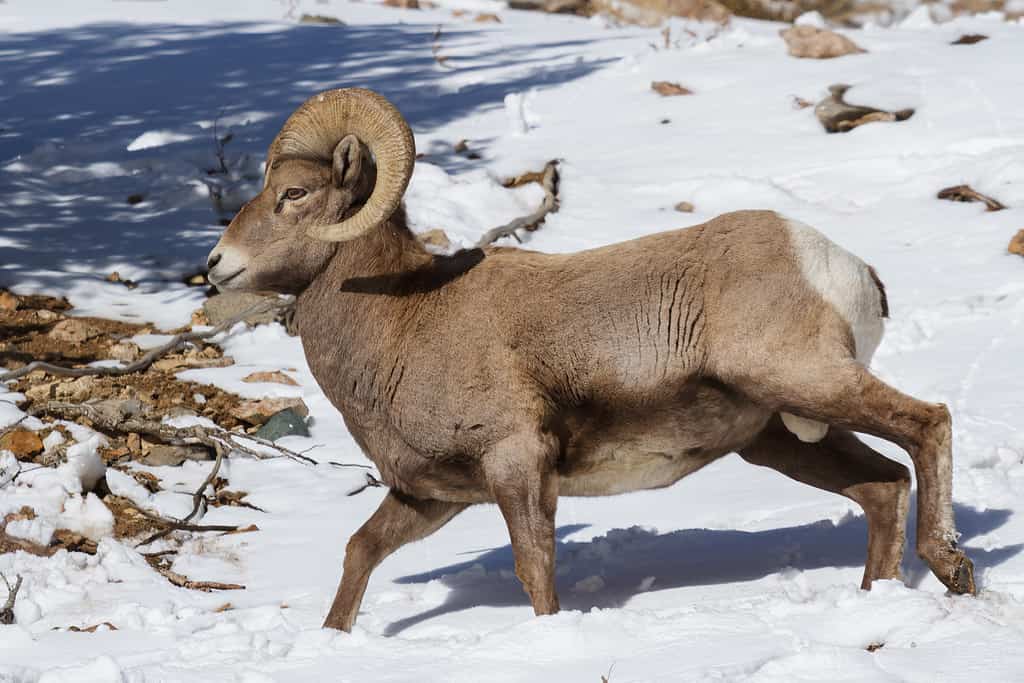
Wild
bighorn sheep
in the Rocky Mountains of Colorado move to winter ranges during cold weather.
©iStock.com/Gary Gray
Wildlife in Colorado have developed many adaptations that help them survive harsh weather. Big game, such as deer, elk, and bighorn sheep live in the Colorado mountains year-round, but they migrate between summer and winter ranges. They also change their diet, seeking out woody shrubs rather than their warm-weather diet of fresh grasses.
Small Mammals
Small mammals, like the snowshoe hare and the ermine, adapt by camouflaging their coats from brown to white. Other small mammals, like pocket gophers and most mice species, burrow deep beneath the snow and earth to stay warm. Some species, such as black bears, marmots, and chipmunks, hibernate when temperatures drop.
Birds
While many bird species migrate away from Denver when the weather turns icy, the city is home to a variety of birds ready to ride out the storms all year. Canada geese are one of the most common birds you will see all winter in the Denver metropolitan area. Junco, small, grey birds often spotted around backyard bird feeders, actually migrate from colder states to overwinter in Colorado.
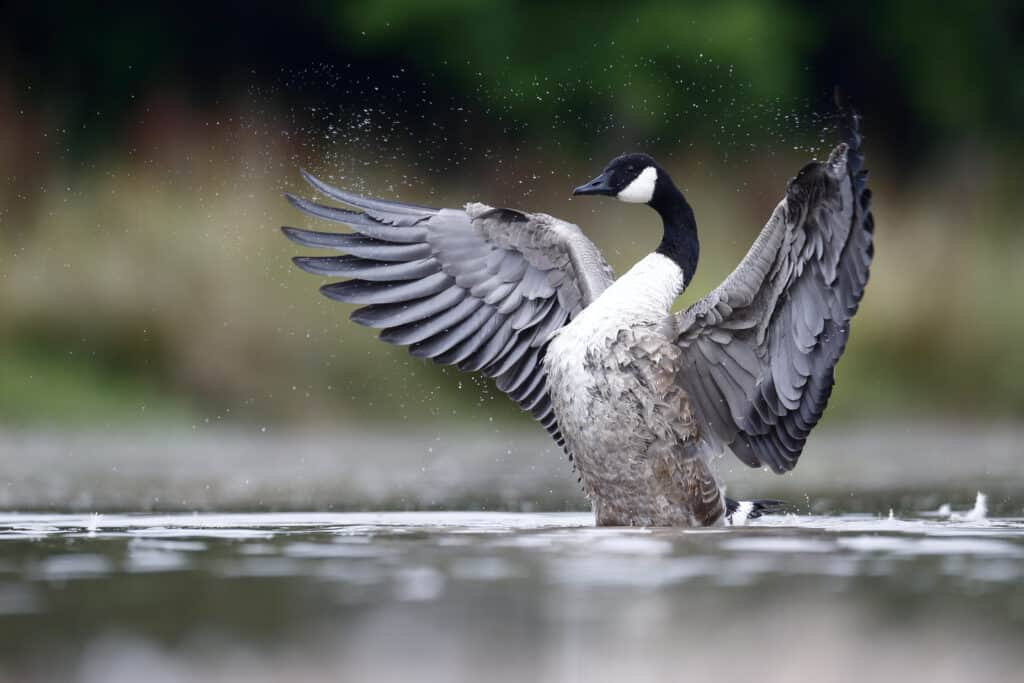
Some populations of Canada geese live in Denver all year.
©Erni/Shutterstock.com
Birds have also evolved many tricks to withstand bad weather. Their skinny legs and little feet have something called counter-current circulation. This adaptation means they have cold blood in their feet so that very little heat is lost when standing on cold ground or even ice. The down feathers underneath a bird’s contour feathers trap warm air and hold it close to their skin.
This is such a great approach to the cold, even humans have adopted the technique and wear down jackets to keep warm. Birds are able to sense when bad weather is approaching and try to bulk up on calories before a storm hits. This gives them the extra nutrients their bodies will need to weather the cold.
Livestock
During the Great Thanksgiving Weekend Blizzard, wildlife utilized their special adaptations to survive the record storm. Colorado is home to 2.6 million cattle, though, along with other livestock animals, many of which live all year outside. While cattle are extremely hardy creatures and can survive winter storms, they require a little help from humans to thrive.

Cattle need a little help from humans when temperatures drop below freezing.
©melissamn/Shutterstock.com
Although domesticated, cattle also have adaptations to keep them warm. They start growing their winter coats in the weeks leading up to winter. Cows also have a secret weapon against freezing temperatures built inside their bodies. Their stomachs act as inner heaters by releasing gas as food ferments in their rumen, the first compartment of a cow’s stomach. This means cows require more calories to stay warm once temperatures approach 32 degrees Fahrenheit. At freezing temperatures, cows will require about 30 percent more feed to maintain a healthy body condition.
Ranchers and farmers need to offer their cattle increased feed, as well as provide windbreaks like stands of trees, buildings, or other man-made structures where cows can ride out severe weather. They also need access to dry bedding near those windbreaks. Just like humans, when cows are wet, cold weather is more dangerous. Record storms have killed tens of thousands of cattle when blizzards have gotten too severe for humans to reach them.
Other Historic Storms That Ruined Thanksgiving Travel

Thanksgiving 1983 wasn’t the only year a major storm put a damper on the holiday.
©iStock.com/pondsaksit
The Great Thanksgiving Weekend Blizzard in 1983 gives most other holiday storms a run for their money, although Turkey Day in 1950 takes the win for the most dramatic Thanksgiving storm.
1950
The Great Appalachian Storm covered Coburn Creek, WV, in a whopping 62 inches of snow. The NWS considers the storm one of the worst wind events ever recorded with winds gusting at 160 mph on Mount Washington, NH. It was the costliest storm up until that point and caused 160 deaths.
1971
The greatest snowfall on record hit Albany, NY, that Thanksgiving with 22.5 inches of snow while areas of the Catskills and the Upper Hudson Valley reported up to 30 inches.
1989
Up to 14 inches of snow blanketed Cape Cod, MA, and 9 inches provided Long Island, NY, with enough for a very white Thanksgiving.
2014
New Hampshire’s fourth greatest power outage in history caused problems not just for travelers but also made cooking a traditional Thanksgiving meal almost impossible. Thanks to this holiday storm, nearly 310,000 customers lost power between New Hampshire, Maine, and Vermont. The storm covered Albany, NY, in 10.4 inches of snow, designating it as one of the worst snowstorms on record for that area.
What Is a Blizzard Anyway?
When Colorado officials declared the Thanksgiving Day storm a blizzard, that meant they expected a lot of snow, right? While snow is a consideration when classifying storms, it isn’t the only factor.
According to the NWS, three factors go into the decision to designate a storm as a blizzard.
- Winds or gusts must be 35 mph or higher.
- Falling or blowing snow must impact visibility to less than a quarter of a mile.
- The combination of wind and snow must last for more than three hours.
Once a storm becomes a blizzard, travel almost always becomes impossible due to “whiteout” conditions and most people need to seek shelter. The upper Midwest and Great Plains regions tend to experience the majority of blizzards in the United States.
Thank you for reading! Have some feedback for us? Contact the AZ Animals editorial team.

